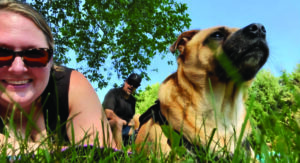 Beth Fisher-Polasky
Beth Fisher-Polasky
There are many ways people are affected by cancer: financially, emotionally, physically, and mentally, to name a few. Before my husband Chris was diagnosed with colorectal cancer in 2017, we were both working full-time. I also worked part-time at my sister’s professional office cleaning business. We had a multigenerational household filled with three teenagers, my mother, two dogs, and two cats. Our lives were busy.
For over a year Chris had mentioned symptoms of colorectal cancer to his primary care provider (PCP): bleeding, bowel changes, bloating, abdominal pain. We both use an Indian Health Services (IHS) facility for our medical care. IHS is a chronically underfunded program provided by the U. S. government to federally recognized tribal nations. According to a recent study, 30% of Native Americans do not have health insurance. IHS facilities are understaffed; most have less than 75% of the necessary medical providers needed to serve Native American patients (Lofthouse). At the time, I was working at the IHS building as a medical assistant and knew more staff was needed. Chris’s provider kept putting off further testing. We were getting desperate. He knew something was wrong as he kept begging to be referred for a colonoscopy. The PCP kept telling him “No” because he was too young and did not have a family history of cancer. I told him to lie to the physician and say there was a family history. He was finally scheduled for a colonoscopy.
 Unable to take the time off from work, I thought about his test all afternoon and hoped the doctor would not find anything. When I received a phone call from the hospital and was asked to meet with the doctor, I left the office crying. I knew it was cancer. We were shown the video from the test as the doctor explained that the cancer looked like it had been there for some time, years probably.
Unable to take the time off from work, I thought about his test all afternoon and hoped the doctor would not find anything. When I received a phone call from the hospital and was asked to meet with the doctor, I left the office crying. I knew it was cancer. We were shown the video from the test as the doctor explained that the cancer looked like it had been there for some time, years probably.
From that moment on, I was in caregiver mode. I showed up for every appointment and test, meeting with the surgeon, and then the oncologist to begin chemotherapy. I continued to work my full- and part-time jobs since Chris was taking time off for the appointments and for days after chemo when he was too sick to go to work. What I remember most is how much I gave of myself mentally and physically during that time. I did not have anyone ask me how I was doing. As a medical professional I was trained to show up no matter what because I was needed. Once the chemo was over, I was suddenly not needed. Depression set in and it took me years to recover from being a caregiver.
There are several things I believe could have been done better. The IHS facility was not the best option for my husband’s care. People have asked why we continued to go, and I tell them that even though I was working a full- and a part-time job, we still were not able to financially support ourselves enough to pay for deductibles, co-pays, and out-of-pocket expenses. We had to accept the care available to us. I also think that the focus of the treatment should not be solely on the patient. If one provider, nurse, office staff would have asked me how I was doing, really doing, things may have ended differently. Encouraging someone to take care of themselves will always be in my mind when I meet other people on the caregiver journey.
When Chris told me that his oncologist suggested POQC/MOQC to him, I was not very interested at first. I was in my first year of the Professional Master of Arts in Social Innovation at Grand Valley State University. But then I thought about our potential impact as Native American (myself) and Alaskan Native (Chris). Historically (and currently) Native Americans and Alaskan Natives were not treated well by public institutions such as the government and medical facilities. Our story highlights reasons for medical mistrust. But I want to change that viewpoint, and POQC/MOQC gives me that opportunity. Medical care should never be anything less than excellent, and we all deserve access to it.
I have recently joined the Recruitment and Retention group. It interests me because there are great opportunities for the group, and I would like to utilize my training and experience with marginalized and oppressed groups – BIPOC, LGBTQIA+, and disabled folks – to find appropriate ways to engage them.
I also recently met with Dr. Griggs to discuss the Equity Task Force and am excited about the implementation of this group’s plans. I think about something a conference speaker recently said when it came to Native Americans being represented in medical studies. We appear as asterisks in the data results, possibly because there were not enough Native Americans to quantify the data. But even if that were true, no one wants to be represented as an asterisk. We must do better to demonstrate inclusiveness and health equity.
Reference: Lofthouse, Jordan, Increasing Funding for the Indian Health Service to Improve Native American Health Outcomes (January 2022). Mercatus Policy Brief Series, Available at SSRN: https://ssrn.com/abstract=4061209 or http://dx.doi.org/10.2139/ssrn.4061209